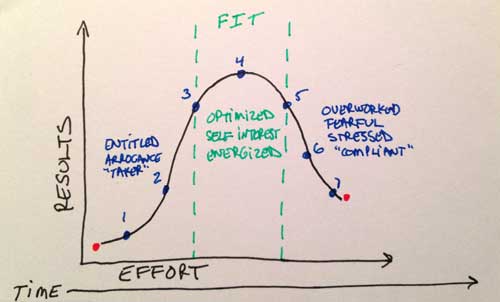Effort, Results, Time and FIT
Effort, Results, Time and FIT
[an excerpt from my future book, “The Human Being’s Guide to Business Growth.”]
Effort, Results, Time, and FIT
Why is this important?
It’s important because in a world where engineers are increasingly convinced that human behavior can be broken down into bits and bytes, this exercise reminds us that we’re not robots. We’re unique human beings with our own unique set of experiences and skills. More importantly, your employees are human beings with their own unique set of experiences and skills. The more we can tap into that uniqueness, that humanity, the more likely we are to tap into a rich vein of productivity.
Let’s look at the graph.
The effort your people put forth is plotted on the x-axis from low to high. The results, or outcomes, that you’re after are on the y-axis. Along the bottom of the graph, we assume results and effort are impacted by time, a non-renewable resource. At the far left, when you have low-effort you get low results. If your people aren’t trying, they aren’t getting the outcomes needed.
On the far right, you are reaching maximum effort, but there’s a law of diminishing returns over time. You can’t run the race at full sprint, all the time, and expect results to stay high.
Assuming those two extremes, results over time will follow a normal distribution along a bell-curve. At points 1 and 2, is entitlement. It’s the employee that is along for the ride, arrogant and labeled a “taker” because they aren’t putting forth the effort nor are they generating results. At points 6 and 7, the employee is putting in tremendous effort, but over time they show signs of results slipping. They are feeling overworked and stressed, maybe working hard out of fear, and labeled “compliant” because they’re compelled to put in the effort for diminishing returns. Somewhere in the middle of the effort/results/time graph we’re going to find optimal performance. That’s where I’ve observed these principles of FIT, where an employee is optimized, working for their rational self-interest and they stay energized.
That comes from alignment with your company’s focus, the employee’s autonomy to use their self-identified strengths to accomplish outcomes, and the continued application of tools and technology to free up the most precious of resources, self-directed time.
Good stuff.


